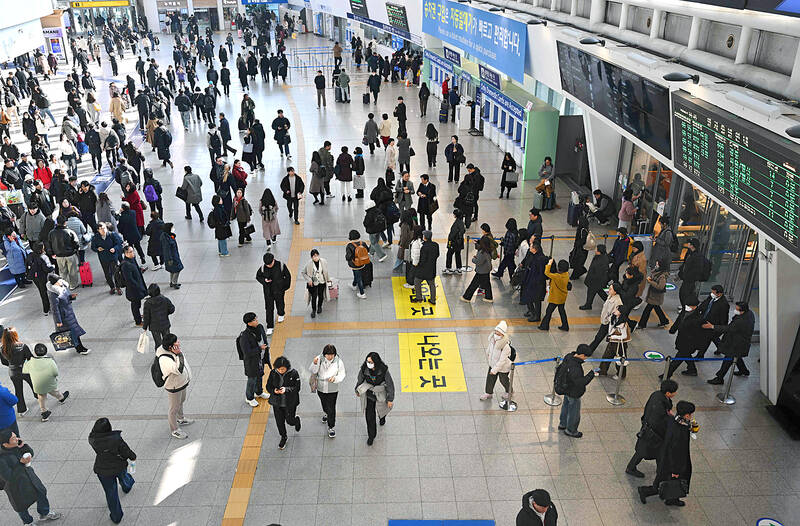The number of births in South Korea rose last year for the first time in more than a decade on the back of a rise in marriages, officials said yesterday, bucking a trend for a country battling a demographic crisis.
South Korea has one of the world’s longest life expectancies and lowest birthrates, a combination that presents a looming demographic challenge.
The South Korean government has poured billions of dollars into efforts to encourage women to have more children and maintain population stability.

Photo: AFP
The crude birthrate — the number of babies born per 1,000 people — was 4.7, interrupting a continuous downward trend since 2014, preliminary data from Statistics Korea showed.
The fertility rate, or the average number of babies a woman is expected to have in her lifetime, was 0.75, “up 0.03 from 0.72 in 2023,” the government agency said in a report.
“The number of births in 2024 was 238,300, an increase of 8,300 (3.6 percent) from the previous year,” the report said.
Statistics Korea official Park Hyun-jeong attributed the rise to an increase in marriages, as well as shifting demographics.
“The population has seen a significant increase in the number of people in their early 30s,” Park told a news conference. “This has had a major impact.”
“Additionally, many marriages that were delayed due to COVID-19 have now taken place, and this upward trend continues,” she added.
The number of marriages last year had been the most since 1996, “the highest on record,” Park said.
The average maternal age at childbirth last year was 33.7 years, the report said, one of the highest in the world.
However, the fertility rate remains far below the 2.1 children needed to maintain South Korea’s population of 51 million.
At current rates, the population will nearly halve to 26.8 million by 2100, according to the Institute for Health Metrics and Evaluation at the University of Washington in Seattle.

‘UNUSUAL EVENT’: The Australian defense minister said that the Chinese navy task group was entitled to be where it was, but Australia would be watching it closely The Australian and New Zealand militaries were monitoring three Chinese warships moving unusually far south along Australia’s east coast on an unknown mission, officials said yesterday. The Australian government a week ago said that the warships had traveled through Southeast Asia and the Coral Sea, and were approaching northeast Australia. Australian Minister for Defence Richard Marles yesterday said that the Chinese ships — the Hengyang naval frigate, the Zunyi cruiser and the Weishanhu replenishment vessel — were “off the east coast of Australia.” Defense officials did not respond to a request for comment on a Financial Times report that the task group from

Chinese authorities said they began live-fire exercises in the Gulf of Tonkin on Monday, only days after Vietnam announced a new line marking what it considers its territory in the body of water between the nations. The Chinese Maritime Safety Administration said the exercises would be focused on the Beibu Gulf area, closer to the Chinese side of the Gulf of Tonkin, and would run until tomorrow evening. It gave no further details, but the drills follow an announcement last week by Vietnam establishing a baseline used to calculate the width of its territorial waters in the Gulf of Tonkin. State-run Vietnam News

DEFENSE UPHEAVAL: Trump was also to remove the first woman to lead a military service, as well as the judge advocates general for the army, navy and air force US President Donald Trump on Friday fired the chairman of the Joint Chiefs of Staff, Air Force General C.Q. Brown, and pushed out five other admirals and generals in an unprecedented shake-up of US military leadership. Trump wrote in a post on Truth Social that he would nominate former lieutenant general Dan “Razin” Caine to succeed Brown, breaking with tradition by pulling someone out of retirement for the first time to become the top military officer. The president would also replace the head of the US Navy, a position held by Admiral Lisa Franchetti, the first woman to lead a military service,

Four decades after they were forced apart, US-raised Adamary Garcia and her birth mother on Saturday fell into each other’s arms at the airport in Santiago, Chile. Without speaking, they embraced tearfully: A rare reunification for one the thousands of Chileans taken from their mothers as babies and given up for adoption abroad. “The worst is over,” Edita Bizama, 64, said as she beheld her daughter for the first time since her birth 41 years ago. Garcia had flown to Santiago with four other women born in Chile and adopted in the US. Reports have estimated there were 20,000 such cases from 1950 to